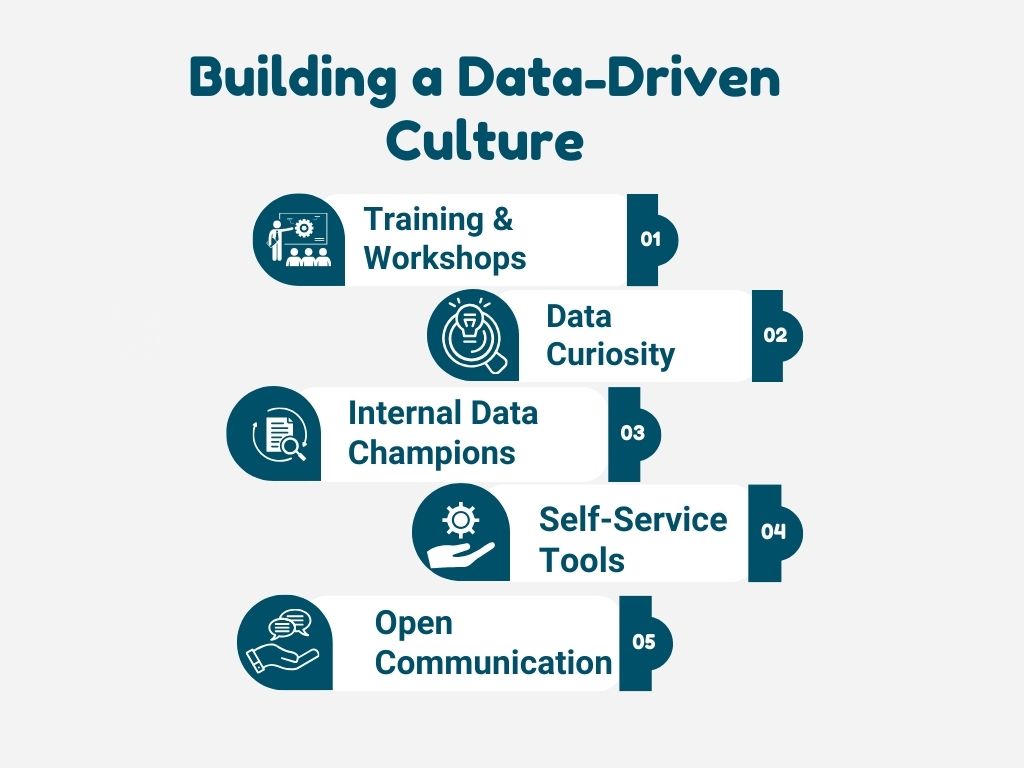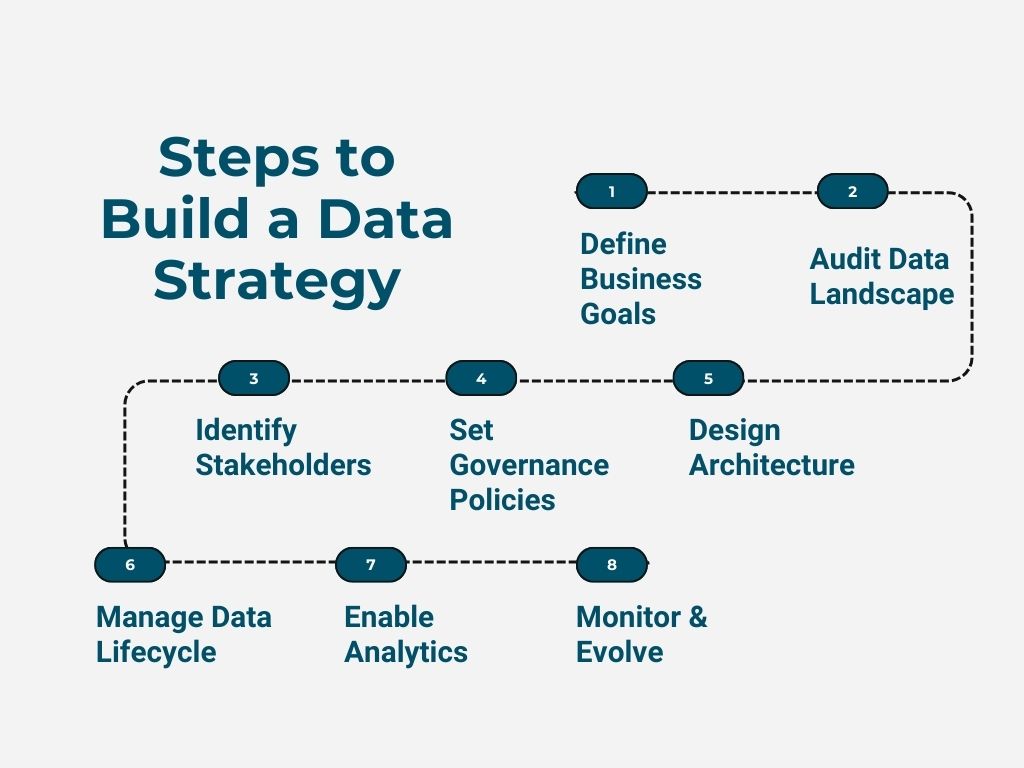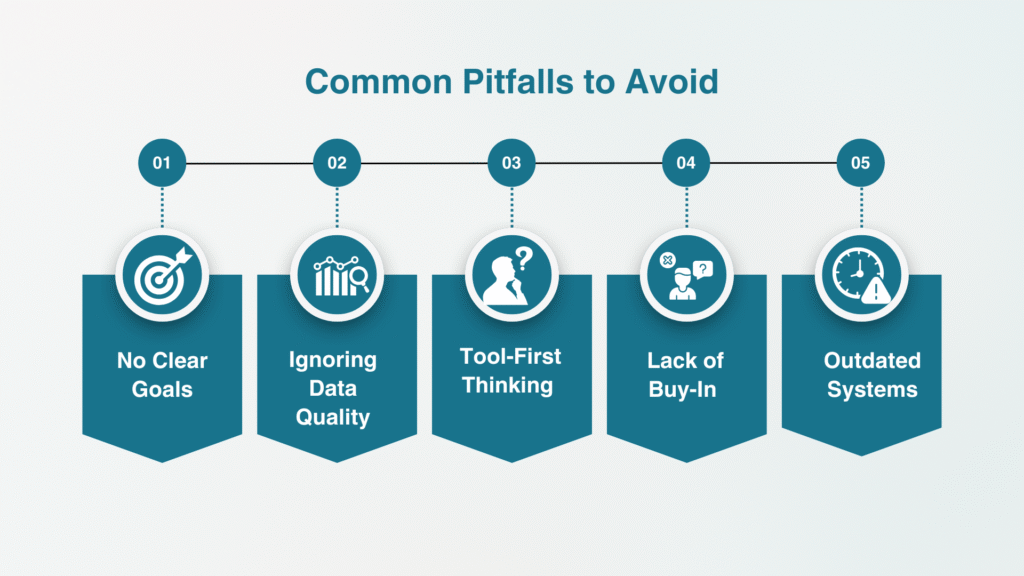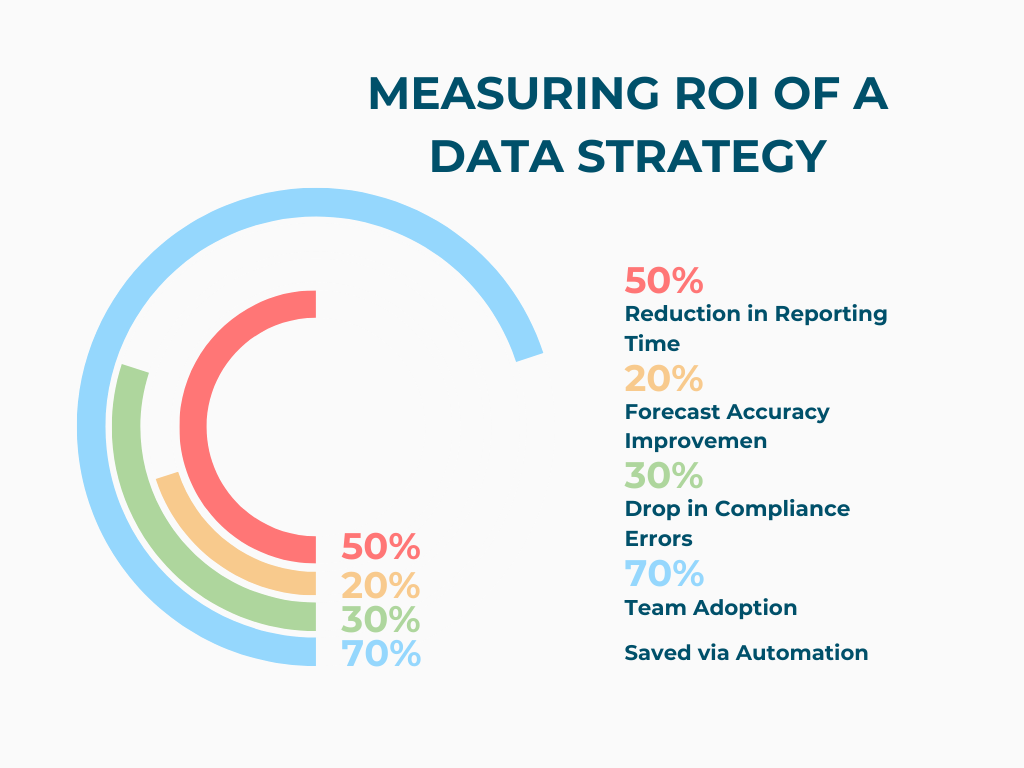In today’s data-driven world, a clear data strategy is essential for turning information into a competitive advantage. It brings alignment across people, processes, and technology, ensuring that data is properly collected, managed, and used. A smart data strategy keeps organizations relevant, innovative, and ready to make informed decisions.
Yet, many companies face hurdles: scattered data, poor quality, and a lack of cross-team coordination. Data silos slow operations. Inconsistent or duplicate data creates errors. And without tying data efforts to real business goals, teams risk going in the wrong direction.
In this blog, we’ll explore what a data strategy is, why it matters, and how to build one. We’ll cover key components like governance, architecture, and analytics and walk you through a step-by-step development guide. You’ll also see a real-world case study of MetroMarket’s transformation and learn how to avoid common pitfalls. By the end, you’ll have a roadmap for building a strategy that drives insight, innovation, and growth.
What Is a Data Strategy?
A data strategy is a long-term plan outlining how a company will manage and use its data. It details the people, processes, and tools needed to transform raw data into insights. More than just tech, a solid data strategy aligns data efforts with business goals and lays the foundation for consistency and trust.
Key Components:
- Data Governance: Sets rules for managing data ownership, quality, privacy, and compliance. Tools like data catalogs and access controls help keep information trustworthy.
- Data Architecture: Covers systems and infrastructure that store, move, and process datalike warehouses, lakes, and pipelines. It must be scalable and accessible.
- Data Quality Management: Ensures data is accurate and reliable using validation, cleansing, and deduplication.
- Data Analytics & BI: Translates data into insights through dashboards, reports, and predictive models.
Benefits:
- Faster Decisions: Timely, reliable data elps leaders act with confidence.
- Operational Efficiency: Centralized data reduces duplication and boosts productivity.
- Revenue Growth: Insights uncover trends and shape smarter products or services.
- Compliance: Governance minimizes misuse and meets legal standards.
How to Develop a Data Strategy
Here’s how to build a strategy that supports your business goals:
1. Define Business Goals
Start by clarifying what your organization wants to achieve. Meet with leadership to identify challenges and success measures. When your strategy is tied to business impact, data work stays focused and effective.
2. Assess the Current Data Landscape
Review your data sources, systems, and quality. Identify gaps, redundancies, and barriers to integration. This baseline lets you map out what needs fixing and where to improve.
3. Identify Key Stakeholders
Involve leaders, technical teams, and data users across departments. Assign roles like data stewards. Create a central data team and steering committee to align efforts and promote accountability.
4. Develop Governance Policies
Establish rules for access, ownership, quality, and retention. Use catalogs, audits, and monitoring tools to ensure policies are followed. This keeps data reliable and secure.
5. Design the Architecture
Build infrastructure that fits your needs. Choose between cloud or hybrid environments, and design secure, scalable data flows. Architecture should grow with your business.
6. Manage the Data Lifecycle
Set up workflows to collect, clean, and store data. Use tools like master data management (MDM) and maintain clear documentation so teams can find and trust the data they use.
7. Enable Analytics and Insights
Provide BI dashboards, reporting tools, and training. Make analytics accessible to non-technical users. As capabilities mature, explore AI and predictive models.
8. Monitor and Improve
Measure KPIs like data quality, usage, and business outcomes. Revisit goals regularly and adapt your strategy as your organization and technologies evolve.
MetroMarket: A Data Strategy in Action
The Challenge:
MetroMarket, a mid-sized retailer, stored sales, customer, and inventory data in silos. This disconnection led to frequent stockouts and inaccurate demand forecasts.
The Approach:
Executives set clear goals to reduce stockouts and increase sales. A data audit revealed duplicate records and system gaps. A cross-functional team built a centralized cloud warehouse, implemented MDM, and rolled out BI dashboards.
The Results:
- 30% drop in stockouts
- 12% sales increase from targeted campaigns
- Faster, more informed decision-making across departments
Pitfalls to Avoid
Even the best data strategies can run into issues. Avoid these common mistakes:
- No Clear Goals: Without aligning efforts to business outcomes, you risk wasting time and money. Always define what success looks like.
- Ignoring Data Quality: Skipping validation and cleanup leads to flawed insights. Prioritize data health from the start.
- Focusing Too Much on Tools: Don’t let technology dictate your direction. Choose tools that serve your businessnot the other way around.
- Lack of Buy-In: A data strategy won’t succeed without organizational support. Train teams, communicate progress, and build a data-driven culture.
- Outdated Infrastructure: Legacy systems can block progress. Invest in scalable, modern platforms that support integration and real-time analysis.
Data Literacy and Culture
Data literacy is the ability of employees at all levels to read, understand, and use data effectively. It’s not just about training analysts—it’s about creating a culture where everyone is confident with data. A strong data culture supports smarter decisions and encourages teams to ask better questions and challenge assumptions.
Foster data literacy by:
- Offering regular training and workshops
- Encouraging curiosity and experimentation with data
- Creating internal data champions
- Making data accessible through self-service tools
When people feel empowered to engage with data, they’re more likely to use it responsibly and consistently. This human element is often the key to unlocking the full value of your data strategy.
Measuring Data Strategy ROI
To prove the value of your data strategy, you need to measure results. ROI doesn’t always show up as direct revenue—sometimes it’s about saved time, reduced risk, or faster decisions.
Track metrics like:
- Reduction in reporting time
- Accuracy of forecasts
- Improved compliance and reduced audit issues
- Growth in data usage across departments
- Cost savings from streamlined operations
Set clear KPIs from the start, and review them regularly with stakeholders. Showing impact reinforces support, guides future improvements, and ensures your strategy evolves with the business.
Essential Tools and Platforms
- Governance & Catalogs: Define rules, manage metadata, and enable data discovery.
- ETL/ELT Tools: Automate data extraction, transformation, and loading.
- MDM Solutions: Create a consistent, unified view of key data entities.
- Cloud Platforms: Scale storage, integration, and analytics easily.
- BI Tools: Empower users with accessible dashboards and reports.
- AI/ML Frameworks: Add predictive insights when your data maturity allows.
Final Thoughts
A strong data strategy turns raw data into actionable insights. It drives smarter decisions, streamlines operations, and fuels growth. Align your strategy with business goals, choose the right tools, and engage your people throughout the process.
Start small if needed, but don’t wait. MetroMarket’s story shows that even modest improvements can have a big impact. Take time to assess your current state, define your direction, and begin shaping a data strategy that supports long-term success.
Book Your Free Strategy Session Now
الأسئلة الشائعة
1. What’s the first step in creating a data strategy?
Start by defining your business goals. Understand what problems you want to solve with data and how success will be measured. Aligning your data strategy to business outcomes ensures it drives real value.
2. Why is data governance important in a data strategy?
Data governance ensures data is accurate, secure, and used consistently. It sets the rules for access, quality, and compliance—helping teams trust the data and reducing risk.
3. How do I know if my organization is ready for advanced analytics or AI?
Readiness depends on having clean, well-integrated data and a clear business use case. Start with foundational data practices, then evaluate your infrastructure and team capabilities before scaling into AI or predictive modeling.
4. What if teams don’t understand or use the data tools provided?
This is where data literacy and culture matter. Provide training, appoint internal champions, and encourage data-driven thinking. Making tools accessible and relevant helps increase adoption.
5. How long does it take to see results from a data strategy?
That depends on your starting point, goals, and resources. Many companies see early wins within a few months—like better reporting or reduced errors—with larger ROI appearing over time as processes mature.












